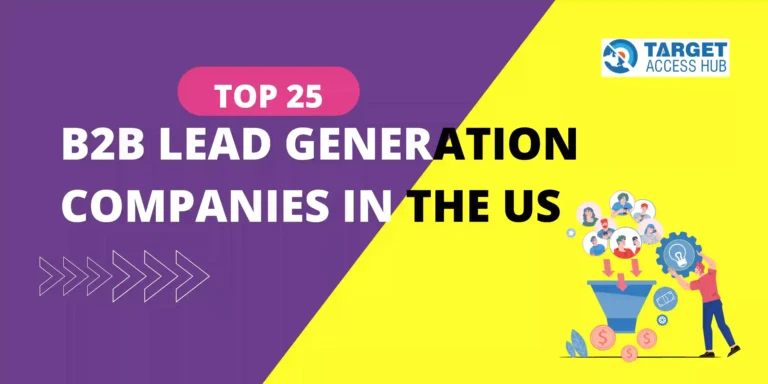Mastering Lead Generation vs. Prospecting: A Strategic Guide

If you are familiar with the world of sales, two terms would have surely stood out to you: lead generation and prospecting. Although often used interchangeably, these terms carry distinct meanings and functions. It goes without saying that mastering them is essential for a robust sales strategy.
This guide aims to unravel the intricacies of lead generation vs prospecting, offering insights into their key differences, common misconceptions, and practical strategies for implementation.
The importance of lead generation and prospecting
- Sales and marketing are symbiotic forces, and at their core lies the interplay between lead generation and prospecting. Lead generation is the heartbeat of marketing, fostering initial interest and inquiries, while prospecting, predominantly a sales responsibility, takes those inquiries and seeks to convert them into customers.
- The harmony between these two processes is fundamental to business growth and revenue generation. Despite their distinct roles, lead generation and prospecting often suffer from semantic confusion.
- Many professionals use these terms interchangeably, leading to a misunderstanding of their individual contributions. To navigate this ambiguity, it is imperative to delve into the unique characteristics of each strategy.

1.Definition of Lead Generation
- Lead generation involves identifying and attracting potential customers, referred to as leads, who have expressed interest in a product or service. This interest is typically demonstrated by providing contact information or engaging with marketing efforts.
- In essence, lead generation is the initiation of consumer interest or inquiry into a business’s products or services. A lead is not merely a name in a database but a potential customer who has shown a level of interest. This could be through downloading a whitepaper, signing up for a newsletter, or any action that signifies a willingness to learn more.
2.Definition of Prospecting
- Prospecting, on the other hand, is the systematic process of identifying potential customers. This is then followed by initiating direct communication to gauge interest and fit for a product or service.
- While lead generation casts a wide net to attract potential customers, prospecting involves a more targeted approach, focusing on individuals or businesses that align with the ideal buyer profile. Prospecting involves researching, identifying, and reaching out to potential customers through various means such as market research, networking, and targeted outreach.
- Unlike lead generation, which is primarily a marketing function, prospecting falls within the domain of sales teams. They take the leads generated by marketing and actively seek out potential customers, aiming to move them through the sales funnel.
Differences between sales prospecting and lead generation
Some key differences include:

1.Distinct goals and objectives:
The primary goal of prospecting is to identify potential customers who fit the ideal buyer profile and initiate direct communication to gauge interest and fit for the product or service. Unlike lead generation, which focuses on creating awareness, prospecting is about immediate engagement and qualification.
2.Methods and approaches used in prospecting:
Prospecting involves active outreach, such as cold calling, networking events, and targeted emails, to engage potential customers directly. It requires a proactive approach from the sales team to identify and convert leads into paying customers.
3.Focus on marketing vs. sales:
Lead generation is a marketing function that focuses on creating awareness and interest through content, advertising, and other channels. It is about casting a wide net to attract potential customers before direct sales engagement.
4.Timeframe and immediacy:
Lead generation often involves a more extended timeframe, nurturing potential customers over time. In contrast, prospecting is more immediate, aiming for direct engagement and conversion.
An exploration of common misconceptions
Misconceptions surrounding lead generation and prospecting often arise due to the interchangeable use of terms. To unravel these misunderstandings, let’s address some common myths:

Myth: Lead generation and prospecting are the same.
- Reality: While interconnected, lead generation and prospecting serve different purposes. Lead generation focuses on creating awareness, while prospecting involves direct engagement and qualification.
Myth: Only the sales team engages in prospecting.
- Reality: While sales teams play a significant role in prospecting, marketing teams also contribute by providing qualified leads through effective lead generation strategies.
- Despite their distinctions, there are instances where lead generation and prospecting converge, highlighting the fluid nature of sales and marketing:
1.Overlap in data collection:
Both lead generation and prospecting require effective data collection and analysis to identify potential customers and tailor outreach strategies.
2.Common tools and technologies:
Marketing automation tools often contribute to both lead generation and prospecting efforts, creating a shared technological foundation.
Ambiguity in understanding these concepts can hinder the effectiveness of sales and marketing efforts. Clear definitions and strategic deployment are essential for success:
3.Alignment for seamless handovers:
Clear distinctions ensure that leads generated by marketing are effectively handed over to the sales team for prospecting and conversion.
4.Resource optimization:
Clarity allows organizations to allocate resources effectively, leveraging the strengths of both teams for maximum impact.
Factors to consider when choosing between the two
- Choosing between lead generation and prospecting requires a thoughtful consideration of various factors. This includes the nature of your target audience, their preferences, and behaviors should inform the decision between lead generation and prospecting.
- Complex products or services may benefit from a prospecting approach. This is because in these cases, direct communication can address specific needs and concerns.
Segmenting your audience
Segmentation is a powerful prospecting strategy, allowing for more targeted and personalized communication:

1.Demographic segmentation:
Grouping prospects based on demographic factors such as age, location, and industry helps tailor communication to specific needs. Implement automated email campaigns that provide valuable content, address pain points, and guide prospects through the sales funnel.
2.Behavioral segmentation:
Analyzing prospect behavior, such as website visits or engagement with marketing materials, provides valuable insights for personalized outreach. Train your sales team to personalize follow-up communications, demonstrating a genuine interest in the prospect’s needs and fostering trust.
Overcoming sales prospecting challenges
Sales prospecting comes with its unique set of challenges. Equip your team with strategies to overcome common hurdles:

1.Handling objections
Sales prospecting is not without its roadblocks, and objections from potential customers are common hurdles that your team must overcome. Objections can range from concerns about pricing to doubts about the product’s suitability. Turning objections into opportunities requires a strategic approach and effective communication skills.
Understanding objection types:
- Equip your team with a comprehensive understanding of the various objection types they might encounter. Whether it’s a product-related concern, a budget constraint, or a need for more information, recognizing objection categories allows for targeted and tailored responses.
Developing objection-handling scripts:
- Provide your team with objection-handling scripts that guide them through common scenarios. These scripts should emphasize active listening, empathy, and a consultative approach to address objections without creating friction.
Role-playing exercises:
- Conduct regular role-playing exercises to simulate objection scenarios. This hands-on practice helps sales reps refine their objection-handling techniques, fostering confidence and adaptability in real-world situations.
Feedback and improvement loop:
- Establish a feedback loop where team members can share successful objection-handling experiences and learn from challenges. Encourage a culture of continuous improvement, emphasizing the importance of adapting strategies based on evolving objections.
2.Effective time management
Time is a precious commodity in sales prospecting. Ensuring that your team maximizes their time for impactful interactions with potential customers is crucial for success.
Prioritizing leads:
Provide tools and guidelines to help your team prioritize leads based on criteria such as likelihood to convert, deal size, and alignment with the ideal customer profile. This ensures that energy and resources are directed towards prospects with the highest potential.
Utilizing CRM tools:
Implement Customer Relationship Management (CRM) tools that not only facilitate lead tracking but also offer insights into lead behavior and engagement. CRM tools can automate routine tasks, allowing your team to focus on high-priority activities.
Time-blocking strategies:
Encourage the adoption of time-blocking techniques, where specific time slots are dedicated to different prospecting activities. This helps prevent multitasking and ensures that reps focus on one aspect of their role at a time, enhancing overall efficiency.
Continuous training on time management:
Offer ongoing training sessions on effective time management techniques. Sales professionals should be well-versed in strategies such as the Pomodoro Technique, time batching, and setting clear daily priorities.
Regular performance assessments:
Implement regular assessments to evaluate how effectively each team member manages their time. This can include tracking key performance indicators (KPIs) related to prospecting efficiency, such as the number of calls made, emails sent, and meetings scheduled.
Customer Relationship Management (CRM) tools:
Implement CRM tools to track leads, manage interactions, and gain insights into customer behavior for more effective lead nurturing.
Marketing automation platforms:
Utilize marketing automation platforms to automate repetitive tasks, segment leads, and deliver personalized content at scale, optimizing your lead generation processes.
Key Differences Between Lead Generation and Sales Prospecting
- Clarify the distinction between leads and prospects to ensure effective communication and engagement. This can go a long way if everyone on your team is clear about who they are attracting and how.
- Leads are potential customers who have shown interest in your products or services, typically by providing contact information. They are at the initial stage of the sales funnel.
- Prospects are leads that have been qualified and are considered more likely to convert into customers. They have moved further down the sales funnel. This further leads us to recognize the importance of distinguishing between warm and cold leads and prospects.
- Warm leads and prospects have shown a higher level of interest and engagement. Tailor your approach to nurture these relationships and guide them toward conversion. Cold leads and prospects require more effort in building awareness and interest. Implement targeted strategies to warm them up and move them through the sales funnel.
Four steps for successful lead generation
Explore a comprehensive approach to lead generation, combining various strategies for maximum impact:

1.SEO optimization:
Invest in keyword research, content creation, and technical SEO to enhance your website’s visibility and attract organic traffic.
2.Targeted advertising:
Develop compelling ad campaigns on platforms like Google Ads and social media to reach specific audiences and generate leads.
3.Lead magnets:
Create valuable resources such as eBooks, webinars, or whitepapers to incentivize users to provide their contact information.
4.Software assistance:
Implement CRM tools and marketing automation platforms to streamline lead management and deliver personalized content.
Four steps for effective sales prospecting
Equip your sales team with a systematic approach to prospecting, addressing challenges and optimizing their efforts:

1.Networking and social media:
Encourage your team to leverage social media platforms and networking events to identify and connect with potential customers.
2.Demographic separation:
Train your team to segment prospects based on demographic characteristics, allowing for more targeted and personalized outreach.
3.The soft sell:
Emphasize the importance of building relationships through a softer, consultative sales approach, focusing on understanding prospects’ needs and providing tailored solutions.
4.Conquering cold calling:
Provide training on effective cold calling techniques, emphasizing the importance of preparation, active listening, and adapting to prospect responses.
Combine Prospecting And Lead Generation For Optimal Results!
Recognize the synergies between lead generation and prospecting. This will help you identify why a combined approach yields superior results:

1.Handoff between marketing and sales:
Clear communication and collaboration between marketing and sales teams ensure a smooth transition of leads, optimizing the prospecting process. Leverage data analytics to gain insights into customer behavior, allowing both teams to make informed decisions and refine their strategies.
2.Comprehensive customer journey:
Integrating lead generation and prospecting creates a cohesive customer journey, from initial awareness through to conversion, fostering a positive customer experience.
3.Unified communication channels:
Ensure that marketing and sales teams share insights and feedback through unified communication channels, fostering continuous improvement.
Conclusion
- By now you must be clear with the fact that mastering lead generation and prospecting requires a nuanced understanding of their definitions, distinctions, and practical strategies. You now know the importance of clarity, the need for a combined approach, and the dynamic nature of sales and marketing.
- To win in this competitive world, sales strategies must adapt to changing landscapes, consumer behaviors, and technological advancements. If you and your sales team accept and embrace a dynamic mindset, you can ensure sustained success and relevance in the long run.





